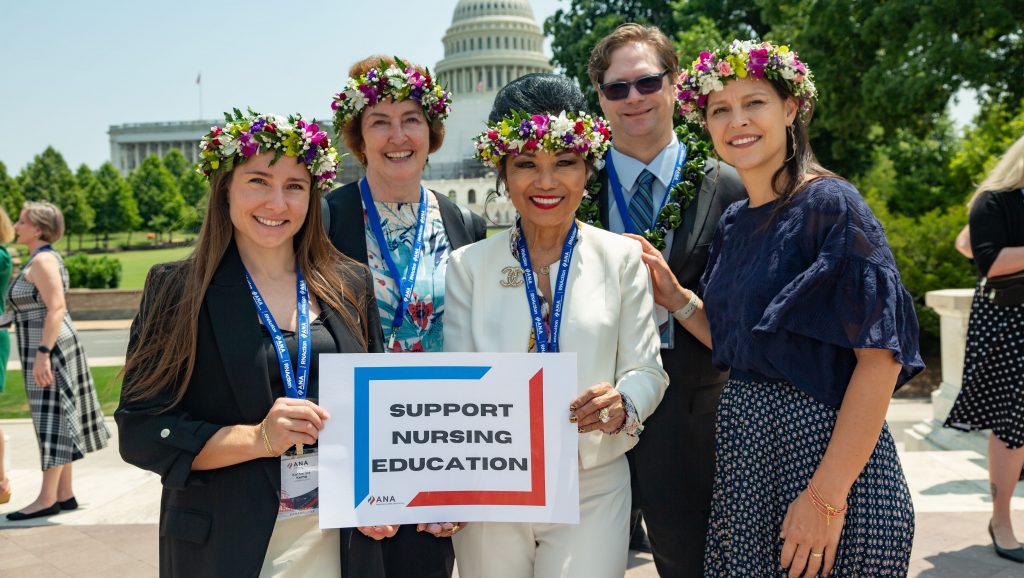During the first quarter of 2024, the American Nurses Association’s Policy & Government Affairs Department collaborated with lawmakers on Capitol Hill on several legislative priorities. Here is a highlight of several initiatives that aim to rebuild the nursing workforce and address work environment challenges facing the nursing profession.
ANA Responds to Problematic Staffing Bill
The House Ways and Means Committee recently approved the Protecting America’s Seniors’ Access to Care Act (HR 7513), which would prohibit the U.S. Centers for Medicare and Medicaid Services (CMS) from finalizing its proposed long-term care safe staffing regulation.
ANA sent a letter to House Leadership expressing its concerns about the bill’s adverse impact on the nursing workforce and the importance of ensuring safe staffing in long-term care facilities. ANA urged Congress to work with the Administration and stakeholders to find a balanced approach to addressing healthcare workforce challenges. It remains to be seen whether House Leadership brings the bill to the floor. Thankfully, the bill is dead on arrival in the Democratic-controlled Senate.
ANA Co-Hosts Workplace Violence Briefing on Capitol Hill
On March 22, ANA co-hosted a congressional briefing on workplace violence in emergency departments along with the Emergency Nurses Association and the American College of Emergency Physicians. Katie Boston-Leary, Director of Nursing Programs at ANA, represented ANA’s perspective on workplace violence in healthcare, its adverse impact on the nursing workforce, and potential solutions for addressing the crisis.
Congress Acts to Provide Mental Health Support for Health Professionals
The House Energy and Commerce Committee recently voted to approve H.R. 7153, a bill that would reauthorize the Dr. Lorna Breen Health Care Provider Protection Act to provide mental health support to healthcare professionals. A companion bill, S. 3679, is pending in the Senate. On that same day, the U.S. Senate passed Senate Resolution 567 to recognize March 18, 2024 as the inaugural “Health Workforce Well-Being Day of Awareness.” A companion resolution is pending in the House (H. Res. 1089).
Congress Invests to Attract More Registered Nurses
Congress recently approved appropriations legislation to fund the federal government through the remainder of Fiscal Year 2024, which ends on September 30, 2024. While most of the Title VIII Nursing Workforce Development Programs and the National Institute of Nursing Research received static funding, Congress approved an increase of $5 million for Title XIII’s Nurse Education, Practice, Quality, and Retention Program for grants to increase the supply of registered nurses, specifically in long-term and acute care settings and in states having the greatest shortages.
ANA Advocates for National Standards at the VA
The House Veterans’ Affairs Committee held an oversight hearing to examine veterans’ access to healthcare services in rural settings through the U.S. Department of Veterans’ Affairs. ANA submitted a statement for the record, urging the VA to develop national practice standards for certified registered nurse anesthetists (CRNAs) that allow them to practice at the top of their license wherever they are needed within the VA health system.
Lawmakers Introduce Bill to Restrict Mandatory Overtime for Nurses
A bipartisan group of lawmakers in both chambers recently introduced the Nurse Overtime and Patient Safety Act (H.R. 7546/S. 3860). This bill would restrict the use of mandatory overtime for nurses with exceptions for federally-declared emergencies. The bill also includes whistleblower and nondiscrimination protections, transparency requirements, and civil penalties. The bill would require the Agency for Healthcare Research and Quality (AHRQ) to conduct a study on standards for safe working hours and the use of mandatory overtime.
House Introduces Legislation to Attract Nurse Faculty
The House recently introduced the Nurse Faculty Shortage Reduction Act (H.R. 7002), which would allow nursing schools to apply for grants from the Health Resources & Services Administration (HRSA) to supplement the difference between what faculty nurses are paid versus what equally trained nurses in clinical practice earn. It is bipartisan and was introduced in the Senate over the summer.
Congress Reintroduces Measure to Support Nursing Workforce Pipeline
The Future Advancement of Academic Nursing (FAAN) Act (H.R.7266/S.3770) was reintroduced in Congress. This legislation calls for critical investments to address immediate nursing education needs, while providing proactive measures to meet future workforce demands, including enrolling and retaining nursing students; hiring and retaining a diverse faculty to educate the future nursing workforce; support schools of nursing in partnership with healthcare facilities, to establish or expand clinical education; and to modernize educational infrastructure.

